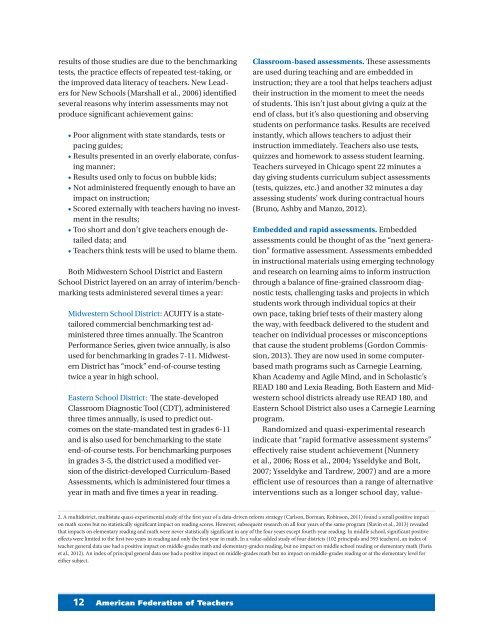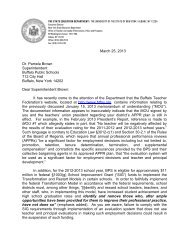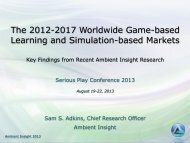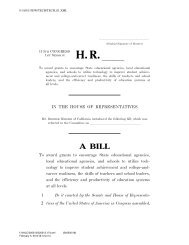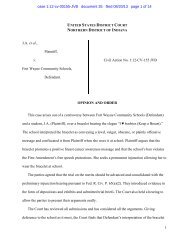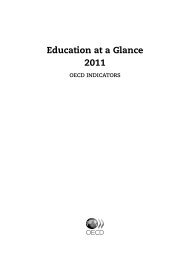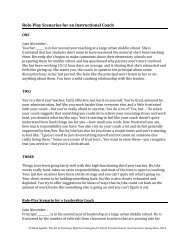Testing More, Teaching Less - American Federation of Teachers
Testing More, Teaching Less - American Federation of Teachers
Testing More, Teaching Less - American Federation of Teachers
- No tags were found...
You also want an ePaper? Increase the reach of your titles
YUMPU automatically turns print PDFs into web optimized ePapers that Google loves.
esults <strong>of</strong> those studies are due to the benchmarkingtests, the practice effects <strong>of</strong> repeated test-taking, orthe improved data literacy <strong>of</strong> teachers. New Leadersfor New Schools (Marshall et al., 2006) identifiedseveral reasons why interim assessments may notproduce significant achievement gains:• Poor alignment with state standards, tests orpacing guides;• Results presented in an overly elaborate, confusingmanner;• Results used only to focus on bubble kids;• Not administered frequently enough to have animpact on instruction;• Scored externally with teachers having no investmentin the results;• Too short and don’t give teachers enough detaileddata; and• <strong>Teachers</strong> think tests will be used to blame them.Both Midwestern School District and EasternSchool District layered on an array <strong>of</strong> interim/benchmarkingtests administered several times a year:Midwestern School District: ACUITY is a statetailoredcommercial benchmarking test administeredthree times annually. The ScantronPerformance Series, given twice annually, is alsoused for benchmarking in grades 7-11. MidwesternDistrict has “mock” end-<strong>of</strong>-course testingtwice a year in high school.Eastern School District: The state-developedClassroom Diagnostic Tool (CDT), administeredthree times annually, is used to predict outcomeson the state-mandated test in grades 6-11and is also used for benchmarking to the stateend-<strong>of</strong>-course tests. For benchmarking purposesin grades 3-5, the district used a modified version<strong>of</strong> the district-developed Curriculum-BasedAssessments, which is administered four times ayear in math and five times a year in reading.Classroom-based assessments. These assessmentsare used during teaching and are embedded ininstruction; they are a tool that helps teachers adjusttheir instruction in the moment to meet the needs<strong>of</strong> students. This isn’t just about giving a quiz at theend <strong>of</strong> class, but it’s also questioning and observingstudents on performance tasks. Results are receivedinstantly, which allows teachers to adjust theirinstruction immediately. <strong>Teachers</strong> also use tests,quizzes and homework to assess student learning.<strong>Teachers</strong> surveyed in Chicago spent 22 minutes aday giving students curriculum subject assessments(tests, quizzes, etc.) and another 32 minutes a dayassessing students’ work during contractual hours(Bruno, Ashby and Manzo, 2012).Embedded and rapid assessments. Embeddedassessments could be thought <strong>of</strong> as the “next generation”formative assessment. Assessments embeddedin instructional materials using emerging technologyand research on learning aims to inform instructionthrough a balance <strong>of</strong> fine-grained classroom diagnostictests, challenging tasks and projects in whichstudents work through individual topics at theirown pace, taking brief tests <strong>of</strong> their mastery alongthe way, with feedback delivered to the student andteacher on individual processes or misconceptionsthat cause the student problems (Gordon Commission,2013). They are now used in some computerbasedmath programs such as Carnegie Learning,Khan Academy and Agile Mind, and in Scholastic’sREAD 180 and Lexia Reading. Both Eastern and Midwesternschool districts already use READ 180, andEastern School District also uses a Carnegie Learningprogram.Randomized and quasi-experimental researchindicate that “rapid formative assessment systems”effectively raise student achievement (Nunneryet al., 2006; Ross et al., 2004; Ysseldyke and Bolt,2007; Ysseldyke and Tardrew, 2007) and are a moreefficient use <strong>of</strong> resources than a range <strong>of</strong> alternativeinterventions such as a longer school day, value-2. A multidistrict, multistate quasi-experimental study <strong>of</strong> the first year <strong>of</strong> a data-driven reform strategy (Carlson, Borman, Robinson, 2011) found a small positive impacton math scores but no statistically significant impact on reading scores. However, subsequent research on all four years <strong>of</strong> the same program (Slavin et al., 2013) revealedthat impacts on elementary reading and math were never statistically significant in any <strong>of</strong> the four years except fourth-year reading. In middle school, significant positiveeffects were limited to the first two years in reading and only the first year in math. In a value-added study <strong>of</strong> four districts (102 principals and 593 teachers), an index <strong>of</strong>teacher general data use had a positive impact on middle-grades math and elementary-grades reading, but no impact on middle school reading or elementary math (Fariaet al., 2012). An index <strong>of</strong> principal general data use had a positive impact on middle-grades math but no impact on middle-grades reading or at the elementary level foreither subject.12 <strong>American</strong> <strong>Federation</strong> <strong>of</strong> <strong>Teachers</strong>


